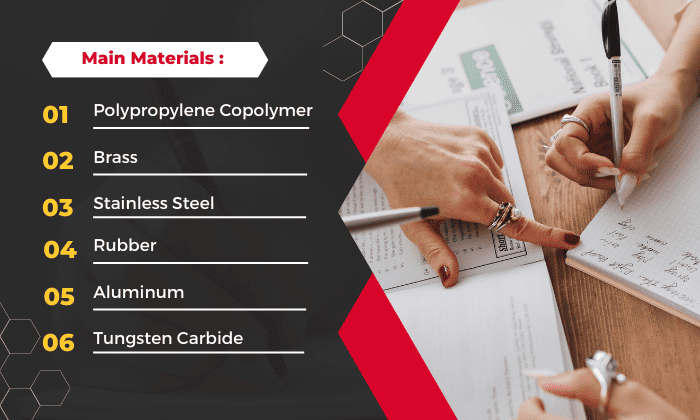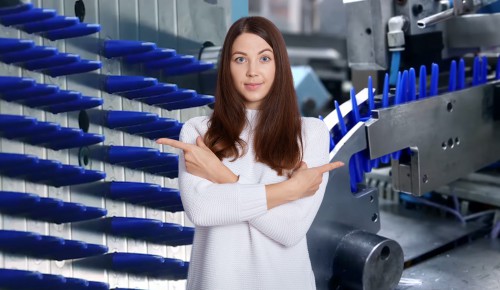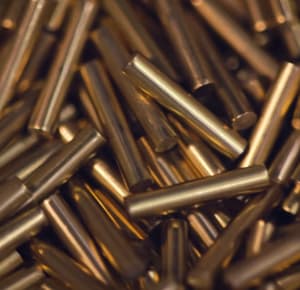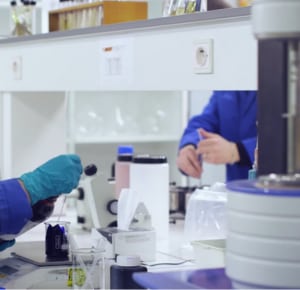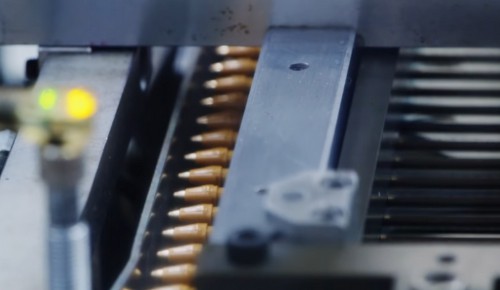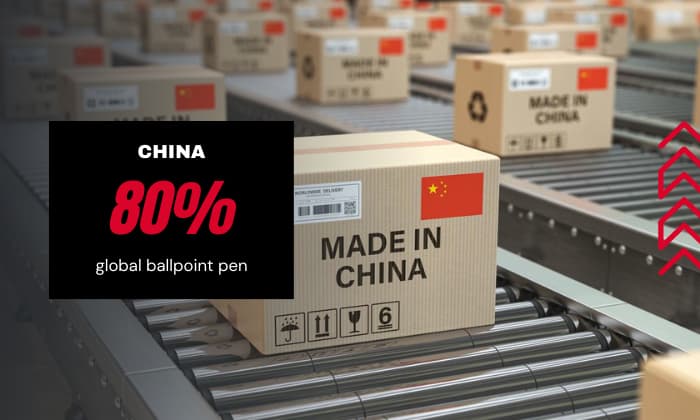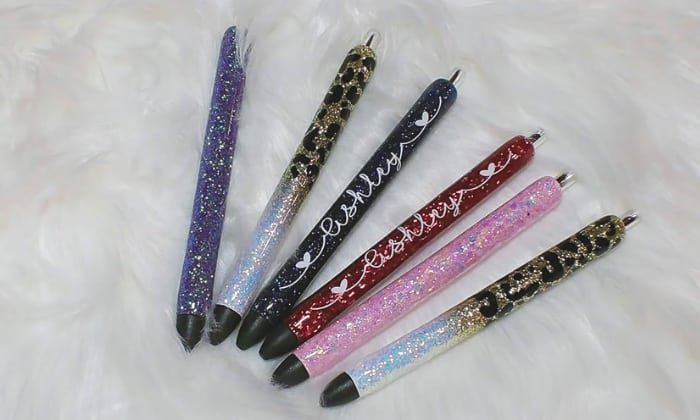Have you ever wondered how ballpoint pens are made?
Right before these ballpoint pens made it to the shelves of an art supply store, these writing implements undergo five fundamental stages of a complex pen manufacturing process to produce different pen parts:
- (1) plastic molding
- (2) compression and formation of flat metal sheets
- (3) filling up ink cartridges
- (4) installation of pen balls
- (5) quality testing.
This comprehensive article helps you gain valuable insights about the commonly used materials in making ballpoint pens.
Table of Contents
Crafting Ballpoint Pens: Discovering the Materials Behind the Product
What are pens made of? Well, ballpoint pens, with their diverse array of materials and designs, encompass a wide range of craftsmanship.
Whether they are everyday writing tools or exquisite works of art, the materials chosen for their construction play a crucial role in their performance and durability.
Here are some of the most common materials in making ballpoint pens:
- Polypropylene Copolymer (PPC). A ballpoint pen made out of PPC is renowned for its lightweight yet robust nature and finds its place in crafting the barrel and cap of plastic pens. This material strikes a balance between strength and weight.
- Brass. With its malleability and resistance to corrosion, brass is also well-known for the creation of ballpoint pen tips. Its versatility allows for precise shaping, ensuring smooth ink flow and a dependable writing instrument.
- Stainless Steel. This material, known for its strength and corrosion resistance, is useful in the springs within pens. Its robustness ensures the longevity of the pen’s retractable mechanism, providing reliable operation over countless clicks.
- Rubber. Often employed as a grip material, rubber enhances writing comfort and control. Its soft and tactile properties provide a secure hold, preventing slippage during extended writing sessions.
- Aluminum. This rust-proof material is also recognized for its lightweight nature and excellent machinability. Indeed, aluminum offers a harmonious blend of aesthetics and functionality.
- Tungsten Carbide. This material works efficiently for ink a
pplication. Its exceptional hardness and deformation resistance make it ideal for crafting durable pen balls that maintain their shape, facilitating consistent and effortless writing.
Decoding the Manufacturing Process of Ballpoint Pens
Each manufacturing process may differ from one ballpoint pen manufacturer to another. However, in this section, we will show you how different parts of a ballpoint pen are generally manufactured step by step.
Plastic components of a ballpoint pen
The plastic elements in a ballpoint pen go through several stages and ultimately form into barrels, ink chamber, clips, and caps.
- The plastic parts are commonly sourced from Polypropylene Copolymer or PPC powder or granules that are carefully sorted out and measured. Afterward, the quantified amount will be transferred into a hopper feeder.
- Once decided which specific component to construct, the PPC granules undergo either extrusion or injection molding.
- Extrusion Process: The extrusion process utilizes heat that transforms the PPC into a dense, malleable substance akin to a thick paste. This element will be molded into a particular shape (typically pen barrels and ink cartridge refills), cooled down, pulled out, and released from the plastic extrusion line.
- Injection Molding: Besides barrels, manufacturers commonly employ this process to engineer the intricate or smaller parts of a ballpoint pen, particularly the clicking parts of a retractable pen, caps, and clips.
This process also utilizes heat to convert the granules or powder into reduced viscous fluid, which is then molded, cooled down, and solidified.
Metal components of a ballpoint pen
The ball, tip, spring, cartridge, and barrel are commonly constructed using metal, which is painstakingly formed under heat and into a compression machine.
- The metal pieces like aluminum, steel, or brass are subjected to heat until they attain a pliable state.
- After that, the heated metal pieces are placed into a compression machine for molding. A part of this machine, which is the stainless steel rod, pushes the metal discs or sheets into a die cast, forming them into their designated shapes with the metal remnants being expelled and recycled.
- The ball, which is the fundamental piece of a ballpoint pen, is made of which material, then? It is typically made of tungsten carbide and readily available for installation toward the end of the pen’s assembly.
Pen ink
- The first step involves combining the raw material and other components in a dedicated tank, where they are meticulously blended according to the closely guarded formula. The ink should be fairly thick, quick-drying, and smooth.
- Certain ingredients may necessitate specific temperature settings to achieve optimal bonding, hence they are added at precise moments and in measured quantities.
- For efficient, accurate, and speedy processes, the manufacturing industry uses automatic mixers to combine all the components to ensure refined and functional writing implements such as ballpoint pens.
These automated machines are modified based on the mixing intervals to gradually introduce pigments and generate a diverse array of ink hues.
Filling ink in ballpoint pens and quality control
When the metal and plastic components of a ballpoint pen have been produced, the next vital process is to fill the ink reservoir or barrel with the manufacturer’s proprietary ink formulations.
- Before assembling the parts and pieces of a ballpoint pen, the ink is injected into the cartridge that is usually made of brass.
- Another automated machine is assigned to fill grease at the opposite end of the ink cartridge to seal and secure the ink inside.
- A centrifugal force takes place as soon as the ink cartridges are positioned inside a centrifuge machine. This process moves ink cartridges in a circular path, thereby pushing the ink down to the ballpoint tip.
- The ink flow and quality are meticulously tested to check any issues like line skips, clogs, and poor pigment quality. Should any of these issues arise on a particular ink batch, it will be rejected.
Where are Ballpoint Pens Made?
Where are pens made? It is a question many pen-lovers have asked before.
Ballpoint pens are produced in various locations, depending on the brand. Therefore, it’s not always clear where each pen actually comes from – manufacturing processes can vary greatly.
However, China has become the undisputed king of ballpoint pen manufacturing, cranking out a mind-boggling 38 billion pens annually. No doubt about it – no country even comes close to comparing with what China Daily calls their “dominant force” in this field.
This impressive figure accounts for approximately 80% of the global ballpoint pen production. With such a significant output, China has become the leading supplier of ballpoint pens.
It is worth noting though that some companies exclusively manufacture their pens in other countries. For instance, you can find ballpoint pens that are made in USA, with notable manufacturers such as Edison Pen Company and Fisher Space Pens.
The Average Cost to Make Ballpoint Pens
The average cost to manufacture ballpoint pens can vary depending on factors such as materials used, production processes, and who made the pen. Below is a table outlining the average costs associated with various components of ballpoint pens.
| Ballpoint Pen Component | Average Weight | Sample Material | Average Cost of the Material | Average Production Cost |
| Barrel | 3.5 grams | PPC | $0.0035 | $0.0033 |
| Ball | 0.0003 grams | Steel | $0.00000018 | $0.00064 |
| Ink | 0.098 grams | Pixie Dust | $0.00098 | Not Applicable |
| Spring | 0.175 grams | Steel | $0.00011 | Not Applicable |
| Ball Socket | 0.159 grams | Steel | $0.000095 | $0.0032 |
| Rear Cap | 0.826 grams | PPC | $0.00083 | $0.0033 |
| Reservoir | 0.474 grams | PPC | $0.00047 | $0.0034 |
| Assembly | 0.731 grams | Not Applicable | Not Applicable | $0.00047 |
| Total: $0.0051 | Total: $0.015 |
Therefore, the total average cost of materials is about $0.015. Overall, the combined average cost of materials and production for an entry-level ballpoint pen amounts to approximately $0.0201 (before shipping and profit).
Frequently Asked Questions
What are the Different Types Of Ballpoint Pens?
Normally, there are six different types of ballpoint pens, each classified according to its barrel type, mechanism, and functionality.
- Disposable Ballpoint Pen. These inexpensive plastic pens are widely used for everyday writing tasks. They are commonly discarded once the ink runs out.
- Fine Writing Ballpoint Pen. Designed to provide a smooth and reliable writing experience, fine-writing ballpoint pens are favored by professionals. They offer improved ink flow and often feature an elegant design reminiscent of fountain pens.
- Click-Action Ballpoint Pen. Commonly referred to as retractable pens, these pens feature a convenient click mechanism engineered with a button on the cap or barrel that extends and retracts the pen tip for writing.
- Twist-Action Ballpoint Pen. By twisting the pen cap clockwise or counterclockwise, the writing point is extended or retracted, offering a simple and effective mechanism.
- Capped Ballpoint Pen. These pens have a removable cap that needs to be taken off before writing. The cap protects the pen tip when not in use.
- Multifunctional Ballpoint Pen. Combining the functionality of a ballpoint pen with other tools, these pens offer additional features such as different-colored inks, clocks, or pocket-knife attachments. They provide versatility for various needs.
Can I Disassemble and Repair a Ballpoint Pen?
Disassembling and repairing a ballpoint pen is possible in some cases, depending on the design and construction of the pen.
However, it may require skill, patience, and specific tools. Not all ballpoint pens are easily repairable, so it’s best to consult the manufacturer’s instructions or seek professional assistance if needed.
Can Ballpoint Pens be Customized or Personalized?
Yes, ballpoint pens can be customized or personalized. Many luxury ballpoints offer free custom engraving, allowing you to add your name or other desired text.
Additionally, you can create your own designs on paper using markers or gel pens, and cut them to fit inside the pen for a unique look. It’s also possible to remove the pen’s end cap to access the ink tube for further customization if needed.
Conclusion
All these phases unfold an elaborate and artistic production that manufactures sophisticated and straightforward ballpoint pen designs. They become accessible to everyone who then uses these pens for a myriad of purposes, whether to jot down notes, sign documents, or make illustrations.
Understanding the intricacies of how ballpoint pens are made holds great significance.
We hope this article equips you with crucial insights into the complexities of ballpoint pens.

Art has always been a part of my life; it influences my upbringing and later my career choice. For me, it is always a part of my parenting technique. So for whichever purpose that you come to art, you can start here with us.

